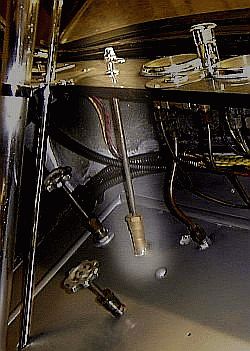If the car is going to be stopped for a period of time this
valve should be closed prior to stopping the car. This should be done for
two reasons. First, if the car is going to be idle for a period of time
(such as at a show) the boiler pressure should be allowed to drop to 400 to
500 PSIG before the car is stopped. This insures that the steam automatic is
calling for the burner to fire. When it comes time to reignite the burner
after it has been off for a period of time, the steam automatic needs to be
calling for the burner to fire.
A review of the piping diagram shows that the steam
automatic is the last valve in the fuel flow to the burner. This is to
prevent the burner from firing if the steam pressure is near or above 600
PSIG (which can happen is the pilot is burning too strongly). If the steam
automatic has closed off fuel flow to the burner because the boiler pressure
is at operating pressure then opening either the firing up valve or the
burner fuel valve will have no effect in lighting the burner. Only after the
car has been driven a short distance will the steam pressure in the boiler
drop sufficiently to allow the steam automatic to start fuel flow to the
burner. At this point it becomes a great deal more difficult to ignite the
burner successfully while also trying to drive the car.
It is also desirable that any fuel under pressure in the
piping between the burner valve and the burner is vaporized and burned
before the car is stopped for a period of time. If the boiler pressure rises
to where the steam automatic stops fuel from flowing to the burner, there
will be fuel under pressure trapped between the steam automatic’s fuel valve
and the burner fuel valve. If the burner fuel valve is subsequently turned
off after the steam automatic has also stopped fuel flow to the burner,
there is a slug of fuel trapped at pressure between the burner fuel valve
and the steam automatic’s fuel valve.
After a period of time the steam pressure of the boiler may
drop sufficiently that he steam automatic calls for the burner to light. The
slug of fuel under pressure runs into the vaporizer. If the vaporizer has
cooled this fuel doesn’t vaporize quickly and it is doesn’t have a constant
pressure to push it out the nozzles. Over time the fuel slowly vaporizes and
gas vents from the jets. Depending on how tight the pilot access door is and
other factors this vapor could ignite with a loud pop and startle anyone
that happens to be nearby the car. As the fuel is only partially vaporized
it tends to take on an unpleasant raw kerosene smell that most find
objectionable.
One thing the Stanley driver must pay attention to when
operating the car is that the firing up valve and the burner valve are never
opened at the same time. A quick examination of the piping diagram reveals
that the firing up valve and the burner valve both share common piping
between each valve and the burner. This means that should the firing up
valve be open or even partially open when the burner valve is opened, the
higher-pressure fuel from the burner fuel system will flow into the lower
pressure fuel of the pilot burner fuel system. The result will be a building
of pressure in the pilot fuel system above it’s normal 25 to 30 PSIG
operating pressure. The pilot will start to burn a more vigorously with the
increased pressure and there is the chance the pilot fuel tank or some of
the pilot fuel system piping could rupture or leak and spray fuel that could
ignite.
Additionally the pilot fuel will become contaminated with
kerosene making it much more difficult to vaporize. Since the pilot burner’s
vaporizer is designed for the easily vaporized pilot fuel (its only a few
inches long and not the nearly 8 feet long like the burner vaporizer), when
the kerosene contaminated pilot fuel reaches the vaporizer it will not be
heated into a gas but will end up being discharged from the pilot nozzles
into the pilot mixing tube. In a short amount of time the pilot burner will
backfire due to being flooded with liquid kerosene.
